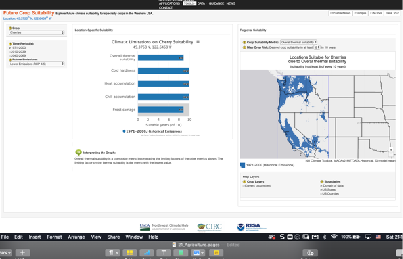21: Climate and Agriculture
Key questions for this investigation
- Where in the Pacific Northwest is it currently suitable to grow certain key crops?
- What determines crop suitability?
- How might this suitability be impacted by the rising regional temperatures forecasted by low and high emission scenarios?
Tool used for this investigation
Future Crop Suitability Tool <https://climatetoolbox.org/tool/ Future-Crop-Suitability> from the Climate Toolbox -University of Merced < https://climatetoolbox.org/tool/Future-Crop-Suitability >
Background
A critical human activity that is heavily impacted by changing climate is agriculture. Because what is grown in a region is determined by temperature and water availability, regional climate change alters what can and cannot be grown there. One measure of an area’s ability to sustain certain crops is thermal suitability. This metric is derived from the range of temperatures in an area, the coldest temperatures a crop can survive, and the amount of heat needed for it reach maturity. Another significant measure is irrigation demand. This is the annual unmet water requirements of a crop that must be provided by irrigation. Obviously, this demand increases whenever the climate of an area becomes warmer and/or drier.
Like Biomes1 ranges migrate as regional climate changes. However, unlike the natural migration of biomes the introduction of crops into new areas requires human intervention to accomplish its purpose, which is to provide a growing human population with food. Two important questions come along with this intervention.
First, is there sufficient water available in the new areas into which crops are introduced? It is important to note that the projected suitability ranges shown in FCST are based on thermal suitability, not irrigation demand.
Second, are regional climate changes taking place slowly enough that the crops introduced into new areas can establish themselves, or will rapidly changing climate create a target that moves too quickly for farmers to adjust?
Investigation
Activity A – Present Crop Suitability Range
Launch the Crop Suitability Tool in your web browser <https://climatetoolbox.org/tool/ Future-Crop-Suitability>. When you do this, you will get a dialog box that will ask you if you want to “Take a tour”, “See an example”, “Set location”, or “Go to tool”. Select the latter. What you will see when you do so should look like figure 1.
 |
Figure 1 – The default screen for the Crop Suitability tool.Crop type is selected from the pull down menu in the upper left the location of areas suitable for growing the crop are shown on the map on the right side of the screen, the time period of the suitability is selected from the pull down menu under the crop selector, and the middle bar chart shows location specific suitability. |
Questions – Current crop suitability
- What are crops listed in the crop selector menu?
- Which tend to be southern crops (abundant in southern Oregon and Idaho)?
- Which tend to be northern crops (abundant in northern Washington and Idaho)?
- How does the climate of the southern areas compare to that of the northern?
- Which tend to be coastal crops?
- Which tend to be inland crops?
- How does the climate of coastlines compare with that of the interior?
Activity B – Changing climate and crop suitability in a low emission scenario
To begin this activity reload the Future Crop Sustainability Tool. By default, the selected crop will be almonds. Starting with this crop, answer the following questions.
Questions – Projected crop suitability (low emission scenario)
- During 1971-2000 where were the locations suitable for growing almonds?
- Keeping future emissions at RCP 4.5 where might you find suitable locations for growing almonds during 2010-2039?
- Again, with future emissions at RCP 4.5 where might you find suitable almond locations during 2040-2069?
- Repeat questions 1 through 3 for the other crops in the list?
- What seems to be the trend in the location and size of the range in which these crops can be grown in the late 21st century?
Activity C – Changing climate and crop suitability in a high emission scenario
For this part of the activity begin by selecting almonds as the crop, set the time period to 1971-2000, and select RCP 8.5 from the future emissions menu.
Questions – Projected crop suitability (high emission scenario)
- For emissions of RCP 8.5 where might you find suitable locations for growing almonds during 2040-2069?
- How does this compare to the suitability range for 2040-2069 under the RCP 4.5 scenario?
- Repeat questions 1 and 2 for the other crops in the list.
- Is the trend in the location and size of the range in which these crops can be grown in the late 21st century consistent between the two scenarios?
Activity D – Synthesis
Questions – Synthesis
- What is happening in terms of climate zones for these suitability ranges to migrate as they do?
- Using only suitability range, which crops would seem to do better in a low emission scenario?
- Using only suitability range, which crops would seem to do better in a high emission scenario?
- The Future Crop Suitability tool shows areas that are thermally suitable for raising selected crops. While the suitability range for any of these crops may expand under RCP 4.5 or RCP 8.5 it does not necessarily mean that these crops will expand into new areas. What other factors besides suitability based on temperature might determine whether these crops could be introduced into new areas?

